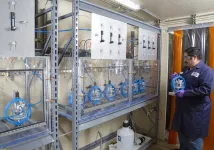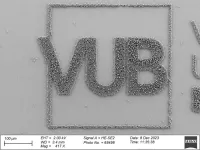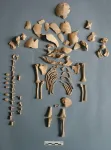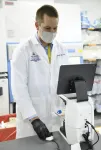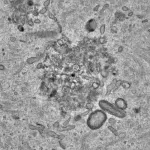(Press-News.org) SAN ANTONIO — February 20, 2024 —Southwest Research Institute will host its second Automotive Corrosion Symposium in Detroit April 11-12. The event, first held in 2022, is designed to foster communication among corrosion experts from within automotive original equipment manufacturers (OEMs) as well as material, paint and other automotive suppliers over a wide spectrum of industry-identified corrosion issues.
“Corrosion is a concern within the automotive industry, not just for cosmetic reasons, but because it can affect functionality and safety,” said SwRI Staff Engineer James Dante, one of the organizers of the event. “As the industry is driven toward high-strength, lighter-weight materials with significantly different corrosion properties, this concern is heightened.”
The symposium is organized by industry professionals addressing automotive corrosion from a variety of technical perspectives. This year’s theme is “Applied Corrosion Science for Next-Gen Vehicles.” The organizing committee is accepting abstracts for papers, presentations and posters through February 23. Abstracts can be submitted through the link below.
“The automotive industry is working to reduce emissions as it develops next-generation vehicles,” Dante said. “Whether improving fuel efficiency or pivoting toward electric vehicles, the need for lightweight, strong materials is exploding. These materials must be inherently corrosion-resistant or suitable protection systems are needed to prevent corrosion.”
SwRI has more than four decades of experience in corrosion and materials failure research. A multidisciplinary group of engineers and scientists offer a comprehensive approach to solving corrosion problems for government and industry. The Institute is home to corrosion testing laboratories that characterize materials in a wide array of caustic environments and develop corrosion-resistant materials and coatings to withstand the harshest environments.
For more information or to register to attend the event, visit https://www.swri.org/event/automotive-corrosion-symposium.
END
SwRI to host second Automotive Corrosion Symposium
Event brings together corrosion experts and automotive industry professionals
2024-02-20
ELSE PRESS RELEASES FROM THIS DATE:
Rutgers professor of computer science is named Sloan Fellow
2024-02-20
A Rutgers professor who studies and improves the design of algorithms – human-made instructions computers follow to solve problems and perform computations – has been selected to receive a 2024 Sloan Research Fellowship.
Aaron Bernstein, an assistant professor in the Department of Computer Science in the School of Arts and Sciences at Rutgers University-New Brunswick, was named one of 126 researchers drawn from a select group of 53 institutions in the U.S. and Canada. The award honors extraordinary creativity, innovation and the potential to become a scientific ...
Challenge Announcement: Global Initiative to Digitalize Scents by the Digital Olfaction Society Revolutionary Scent Digitalization Challenge 2025: Capturing Aromas to Reproduce Anywhere
2024-02-20
Tokyo, The Digital Olfaction Society (DOS) announces a global initiative for 2025, aiming to digitize and transmit scents from various locations around the world for reproduction in Tokyo. This project intends to capture a wide range of fragrances representing the cultural diversity of the globe, leading to a significant development in Tokyo.
Invitation for Worldwide Participation
DOS invites teams from around the world to participate in this initiative. Whether located in major cities such as Berlin, New York, Dubai, or any place with a distinctive aroma, contributions ...
VUB researchers assemble patterns of micro- and nanoparticles
2024-02-20
Researchers from the Department of Chemical Engineering at the Vrije Universiteit Brussel, Riga Technical University and the MESA+ Institute at the University of Twente have succeeded in arranging very small particles (10 µm to 500 nm, 10 to 100 times thinner than a human hair) in a thin layer without using solvents. This is a hugely important first step towards developing a new generation of sensors and electronics for a wide range of applications.
“Common methods based on crystallising solutions are ...
Ancient DNA reveals Down syndrome in past human societies
2024-02-20
By analysing ancient DNA, an international team of researchers have uncovered cases of chromosomal disorders, including what could be the first case of Edwards syndrome ever identified from prehistoric remains.
The team identified six cases of Down syndrome and one case of Edwards syndrome in human populations that were living in Spain, Bulgaria, Finland, and Greece from as long ago as 4,500 years before today.
The research indicated that these individuals were buried with care, and often with special grave goods, showing that they were appreciated as members of their ancient societies.
The global collaborative study, led by first author Dr ...
Smiling is the secret to seeing happiness, new research reveals
2024-02-20
Smiling for just a split second makes people more likely to see happiness in expressionless faces, new University of Essex research has revealed.
The study led by Dr Sebastian Korb, from the Department of Psychology, shows that even a brief weak grin makes faces appear more joyful.
The pioneering experiment used electrical stimulation to spark smiles and was inspired by photographs made famous by Charles Darwin.
A painless current manipulated muscles momentarily into action – ...
Antil studying efficient algorithms for optimization problems with PDE constraints
2024-02-20
Harbir Antil, Professor, Mathematical Sciences; Director, Center for Mathematics and Artificial Intelligence (CMAI), received funding for the project: “Efficient Algorithms for Optimization Problems with PDE Constraints.”
Antil and his collaborators are examining generic optimization problems constrained by partial differential equations (PDEs) with or without uncertainty. In case of uncertainty, a risk-averse optimization framework will be developed. Decomposition and Compression techniques will be utilized to overcome the high computational costs. Several applications in various disciplines such ...
Age-related changes in fibroblast cells promote pancreatic cancer growth and spread
2024-02-20
Older people may be at greater risk of developing pancreatic cancer and have poorer prognoses because of age-related changes in cells in the pancreas called fibroblasts, according to research led by investigators from the Johns Hopkins Kimmel Cancer Center, the Johns Hopkins Bloomberg School of Public Health and the Bloomberg~Kimmel Institute for Cancer Immunotherapy.
The study, published online Feb. 8 in Cancer Research, provides clues as to why pancreatic cancer is more common and aggressive in older people. It may also help scientists develop ...
University of Birmingham signs pioneering collaboration agreement with Vital Energi
2024-02-20
The University of Birmingham has signed a collaboration agreement with Vital Energi to develop and commercialise a range of innovative thermal storage solutions, which will help accelerate decarbonisation within the heating and cooling sector.
The University and Vital Energi will work together over an initial four years to continue the development of thermal storage Intellectual Property (IP) with a view to bringing a number of products to market. As part of the agreement, the University has assigned several IP rights, including a number of patents, to Vital Energi.
The implementation of thermal energy storage is imperative to address the challenges posed ...
Oocytes outsmart toxic proteins to preserve long-term female fertility
2024-02-20
Oocytes are immature egg cells that develop in almost all female mammals before birth. The propagation of future generations depends on this finite reserve of cells surviving for many years without incurring damage. In mice, this can be a period of up to eighteen months, while in humans it can last almost half a century, the average time between birth and menopause. How the cells accomplish this remarkable feat of longevity has been a longstanding question.
Researchers at the Centre for Genomic ...
The Radcliffe Wave is waving
2024-02-20
A few years ago, astronomers uncovered one of the Milky Way’s greatest secrets: an enormous, wave-shaped chain of gaseous clouds in our sun’s backyard, giving birth to clusters of stars along the spiral arm of the galaxy we call home.
Naming this astonishing new structure the Radcliffe Wave, in honor of the Harvard Radcliffe Institute, where the undulation was originally discovered, the team now reports in Nature that the Radcliffe Wave not only looks like a wave, but also moves like one – oscillating through space-time much like “the wave” moving through a stadium full of fans.
Ralf Konietzka, the paper’s ...
LAST 30 PRESS RELEASES:
Injectable breast ‘implant’ offers alternative to traditional surgeries
Neuroscientists devise formulas to measure multilingualism
New prostate cancer trial seeks to reduce toxicity without sacrificing efficacy
Geometry shapes life
A CRISPR screen reveals many previously unrecognized genes required for brain development and a new neurodevelopmental disorder
Hot flush treatment has anti-breast cancer activity, study finds
Securing AI systems against growing cybersecurity threats
Longest observation of an active solar region
Why nail-biting, procrastination and other self-sabotaging behaviors are rooted in survival instincts
Regional variations in mechanical properties of porcine leptomeninges
Artificial empathy in therapy and healthcare: advancements in interpersonal interaction technologies
Why some brains switch gears more efficiently than others
UVA’s Jundong Li wins ICDM’S 2025 Tao Li Award for data mining, machine learning
UVA’s low-power, high-performance computer power player Mircea Stan earns National Academy of Inventors fellowship
Not playing by the rules: USU researcher explores filamentous algae dynamics in rivers
Do our body clocks influence our risk of dementia?
Anthropologists offer new evidence of bipedalism in long-debated fossil discovery
Safer receipt paper from wood
Dosage-sensitive genes suggest no whole-genome duplications in ancestral angiosperm
First ancient human herpesvirus genomes document their deep history with humans
Why Some Bacteria Survive Antibiotics and How to Stop Them - New study reveals that bacteria can survive antibiotic treatment through two fundamentally different “shutdown modes”
UCLA study links scar healing to dangerous placenta condition
CHANGE-seq-BE finds off-target changes in the genome from base editors
The Journal of Nuclear Medicine Ahead-of-Print Tip Sheet: January 2, 2026
Delayed or absent first dose of measles, mumps, and rubella vaccination
Trends in US preterm birth rates by household income and race and ethnicity
Study identifies potential biomarker linked to progression and brain inflammation in multiple sclerosis
Many mothers in Norway do not show up for postnatal check-ups
Researchers want to find out why quick clay is so unstable
Superradiant spins show teamwork at the quantum scale
[Press-News.org] SwRI to host second Automotive Corrosion SymposiumEvent brings together corrosion experts and automotive industry professionals
